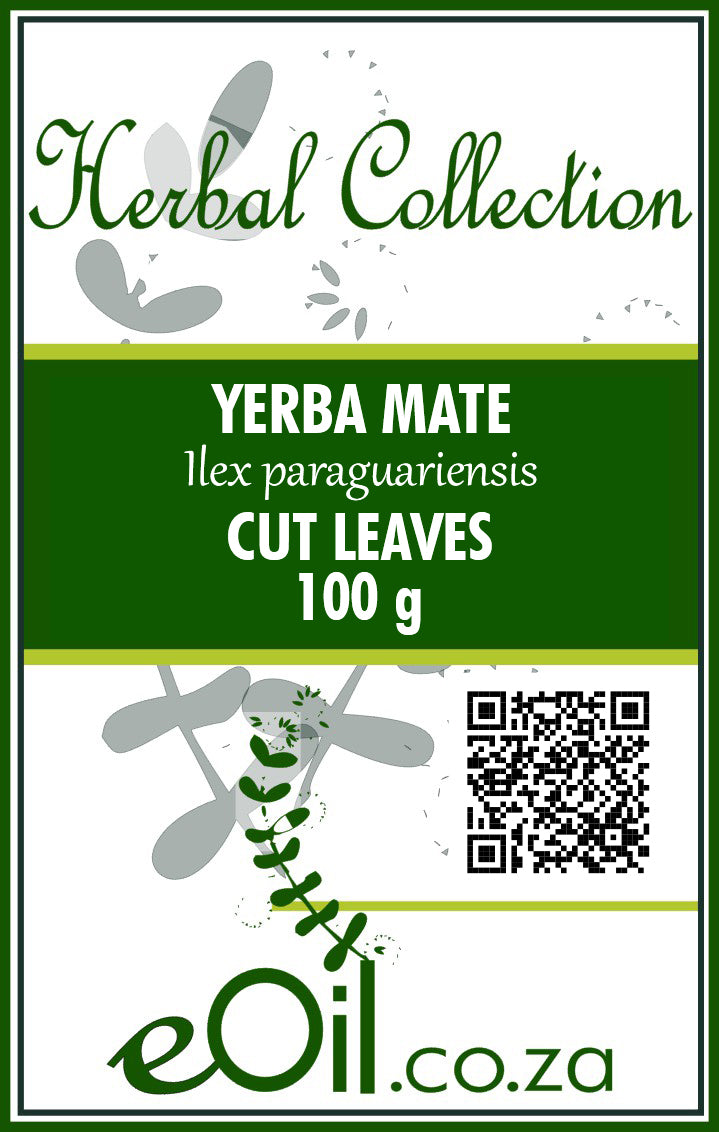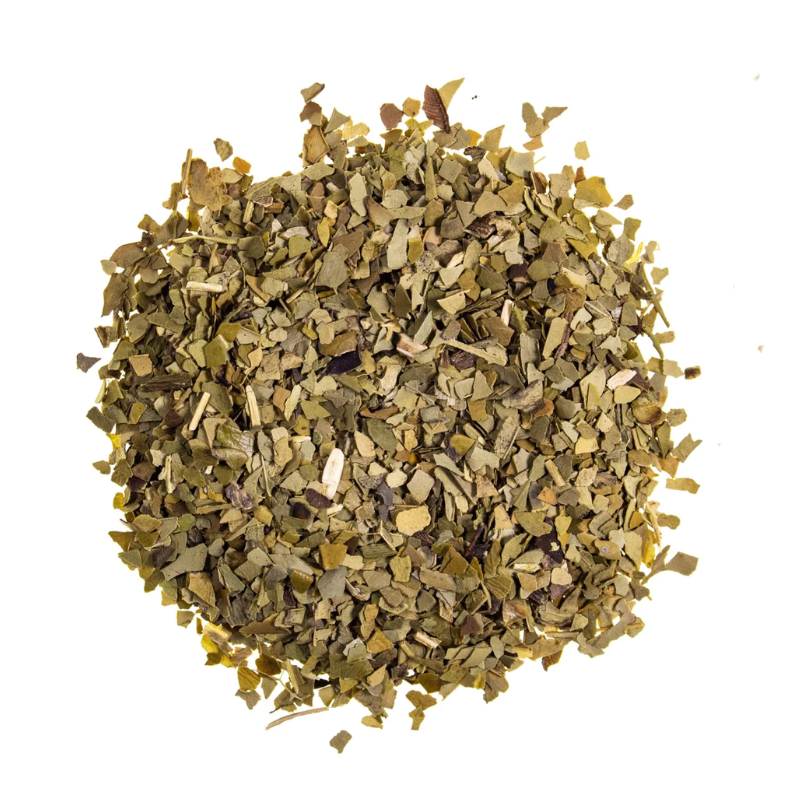Mate Tea ( Yerba Mate ) - Herbal Collection
Mate Tea ( Yerba Mate ) - Herbal Collection - 100 g / Bold is backordered and will ship as soon as it is back in stock.
Description
Description
TRADITIONALLY USED FOR
What is Yerba Mate?
Yerba mate is a caffeinated beverage made from the dried leaves and twigs of the Ilex paraguariensis plant. It originates from South America and has a slightly bitter, grassy, and somewhat smoky flavor.
Traditional Uses
Yerba mate has been a cultural staple in South America for centuries. Its traditional uses include:
- Energy and Focus: The natural caffeine offers a stimulating effect, promoting alertness and focus, but without the jitters often associated with coffee.
- Nutrition: Yerba mate provides vitamins, minerals, and antioxidants.
- Social Ritual: Sharing mate with friends and family is a deeply-rooted social tradition in countries like Argentina, Uruguay, Paraguay, and Brazil.
- Digestive Support: May help ease digestive issues.
- Potential Health Benefits: Some studies suggest potential benefits like improved cholesterol levels and weight management, but more research is needed.
- Weight management, Fat burn and weight loss help
How to Prepare Yerba Mate Traditionally
You'll need:
- Gourd (Mate): Traditionally, a hollowed-out calabash gourd is used, but ceramic, wood, or metal variations also exist. If no Gourd, use it as a normal tea
- Bombilla: A special metal straw with a filter at the base to strain out the leaves.
- Yerba Mate: Loose-leaf yerba mate
- Hot Water: Ideally between 160-175°F (70-80°C) not boiling
Instructions
Absolutely! Here's how to prepare yerba mate like normal tea if you don't have a gourd and bombilla:
Methods
You have a few options:
- French Press:
- Add 1-2 tablespoons of loose-leaf yerba mate to your French press.
- Fill with hot water (160-175°F / 70-80°C).
- Steep for 3-5 minutes. Carefully press the plunger down.
- Pour and enjoy!
- Tea Infuser or Teapot:
- Place 1-2 tablespoons of yerba mate into your infuser or teapot.
- Add hot water (160-175°F / 70-80°C).
- Steep for 3-5 minutes.
- Remove the infuser or strain the tea into your cup.
Important Tips
- Don't use boiling water: This will make your mate excessively bitter.
- Experiment with steep time: Start at 3 minutes and adjust for your taste preference.
- Adjust the amount: Use more or less yerba mate to control the strength of your tea.
- Re-steeping: You can often re-steep yerba mate leaves a couple of times, though the flavor will become milder with each infusion.
Keep in Mind
While these methods offer convenience, the traditional preparation in a gourd provides a unique experience and better control over the mate's strength throughout the drinking session.
- Fill the Gourd (or the teapot) : Fill the gourd about 2/3 to 3/4 full of yerba mate.
- Tilt and Shake: Cover the gourd with your hand and tilt it to one side, so the yerba mate gathers on one side. Gently shake to mix the fine dust with the larger leaves.
- Create a Well: Gently tilt the gourd back, leaving a space on the side where the yerba mate was gathered. This is where you'll pour the water.
- Add a Little Cold Water: Add a small splash of cold water to the empty space to prevent the leaves from burning.
- Insert Bombilla: Carefully insert the bombilla into the empty space, reaching the bottom of the gourd. Don't move it too much once inserted.
- Add Hot Water: Gently pour hot water into the empty space, filling it about 3/4 full.
- Drink: Sip through the bombilla. Enjoying mate is a continuous process where you refill the gourd with hot water as you drink. Traditionally the gourd is passed around.
Important Notes:
- Water Temperature: Using boiling water will make your mate overly bitter.
- Variety: Yerba mate comes in different varieties (with/without stems, aged, flavored), which affect the taste.
SUAVE vs STRONG MATE
Here's a table comparing the health and well-being aspects of suave yerba mate and bold yerba mate varieties:
| Aspect | Suave Yerba Mate | Bold Yerba Mate |
|---|---|---|
| Antioxidant properties | High | High |
| Energy boost | Moderate | Strong |
| Caffeine content | Lower | Higher |
| Digestive comfort | Generally gentler | May be more intense |
| Weight management support | Present | Present |
| Cardiovascular support | Present | Present |
| Nutrient content | Rich in vitamins and minerals | Rich in vitamins and minerals |
| Stimulant effect | Milder | More pronounced |
| Potential for jitters | Lower | Higher |
| Suitability for caffeine-sensitive individuals | Better | May be too strong |
| Hydration properties | Good | Good |
| Potential for improved focus | Moderate | High |
| Adaptogenic properties | Present | Present |
| Potential for sleep disruption if consumed late | Lower | Higher |
t's important to note that the differences highlighted in this table are general trends. Individual yerba mate brands and products may vary, and personal experiences can differ based on factors such as preparation method, serving size, and individual tolerance.
Both suave and bold varieties offer significant health benefits when consumed as part of a balanced diet and healthy lifestyle.
HOW TO PREPARE YERBA MATE
Yerba mate has a distinctive flavor profile that can take some time to fully appreciate.
While it's often described as earthy or grassy, the taste can vary depending on several factors:
Preparation method: Proper preparation is key to unlocking yerba mate's full flavor. We recommend using water heated to around 160-170°F (71-77°C) - not boiling - and allowing it to steep for 3-5 minutes.
Ratio: Try adjusting the amount of yerba mate used. A general guideline is 1 tablespoon per 8 oz of water, but you can experiment to find your preferred strength.
Brewing time: Longer steeping times will result in a stronger, more robust flavor.
Acquired taste: Like many herbal teas, yerba mate's flavor can be an acquired taste that develops over time as your palate adjusts.
Our yerba mate is imported directly from Argentina's leading yerba mate producers
This ensures you're getting an authentic, high-quality product with the traditional flavor profile cherished in Argentina.
If you're finding the taste too subtle, you might try:
Using slightly more yerba mate per serving
Steeping for a longer period
Experimenting with water temperature
Remember, yerba mate is valued not just for its taste, but also for its potential health benefits and energizing effects.
We encourage you to continue exploring different preparation methods to find what works best for you.
CAUTION
Store in a cool, dry place, away from light. Keep tightly closed, away from the reach of Children and pets.
Do not exceed the daily dose.
This product is not intended to prevent or cure any form of illness or disease.
If you are pregnant or nursing ; If you have a medical condition or are in the course of medical treatment ; If you are programmed for theater/operation in the near future, please consult your healthcare practitioner before using this product.
This product cannot replace a varied and balanced diet and a healthy lifestyle.
This product has not been evaluated by the SAHPRA for its quality, safety or intended use.
For More Information please check our General Safety Herbal products Page

Mate Tea ( Yerba Mate ) - Herbal Collection - 100 g / Bold is backordered and will ship as soon as it is back in stock.






